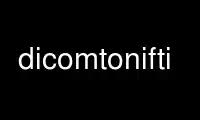
This is the command dicomtonifti that can be run in the OnWorks free hosting provider using one of our multiple free online workstations such as Ubuntu Online, Fedora Online, Windows online emulator or MAC OS online emulator
PROGRAM:
NAME
dicomtonifti - vtk-dicom CLI
DESCRIPTION
usage:
dicomtonifti -o file.nii file1.dcm [file2.dcm ...]
dicomtonifti -o directory --batch file1.dcm [file2.dcm ...]
options:
-o <output.nii[.gz]>
The output file (or directory, if --batch).
-z --compress
Compress output files.
-r --recurse
Recurse into subdirectories.
-b --batch
Do multiple series at once.
-s --silent
Do not echo output filenames.
-v --verbose
Verbose error reporting.
-L --follow-symlinks
Follow symbolic links when recursing.
--fsl Format axial image for use in FSL.
--reformat-to-axial
Reformat the image into axial orientation.
--no-slice-reordering
Never reorder the slices.
--no-row-reordering
Never reorder the rows.
--no-column-reordering
Never reorder the columns.
--no-reordering
Never reorder slices, rows, or columns.
--no-qform
Don't include a qform in the NIFTI file.
--no-sform
Don't include an sform in the NIFTI file.
--volume N
Set the volume to output (starts at 0).
--version
Print the version and exit.
--build-version
Print source and build version.
--help Documentation for dicomtonifti.
This program will convert a DICOM series into a NIfTI file.
It reads the DICOM Position and Orientation metadata, and uses this information to
generate qform and sform entries for the NIfTI header, after doing a conversion from the
DICOM coordinate system to the NIfTI coordinate system.
By default, it will also reorder the columns of the image so that columns with higher
indices are further to the patient's right (or in the case of sagittal images, further
anterior). Likewise, rows will be rearranged so that rows with higher indices are
superior (or anterior for axial images). Finally, it will reorder the slices so that the
column direction, row direction, and slice direction follow the right-hand rule.
It is also possible to reformat the images into the axial orientation via the
--reformat-to-axial option This option is mutually exclusive with the no-reordering
options. The resulting orientation matrix will be the identity matrix.
If the output NIFTI files are to be used with the FMRIB FSL package, then use the --fsl
option to reformat the images to match the standard FSL orientation: axial images with the
slices arranged from inferior to superior, column number increasing from right to left,
and row number increasing from posterior to anterior. This will also convert the data
type from unsigned 16-bit to signed 16-bit if necessary.
If batch mode is selected, the output file given with "-o" can be constructed from DICOM
attributes, by providing the attribute names within curly braces. For example, consider
the following: "{PatientID}-{StudyDate}/{SeriesDescription}-{SeriesNumber}.nii" or
something similar to produce a hierarchichal directory structure. The attributes used in
the path should be from the following list:
PatientID, PatientName, PatientBirthDate, PatientSex, StudyID, StudyDescription,
StudyDate, StudyTime, StudyInstanceUID, SeriesNumber, SeriesDescription,
SeriesInstanceUID, Modality, AccessionNumber.
Here is an example of batch mode that recurses into subdirectories and compresses the
output files, putting the results in the current directory:
./obj-x86_64-linux-gnu/bin/dicomtonifti -brz -o {SeriesDescription}-{SeriesNumber}.nii
/path/to/dicom/files
Use dicomtonifti online using onworks.net services
